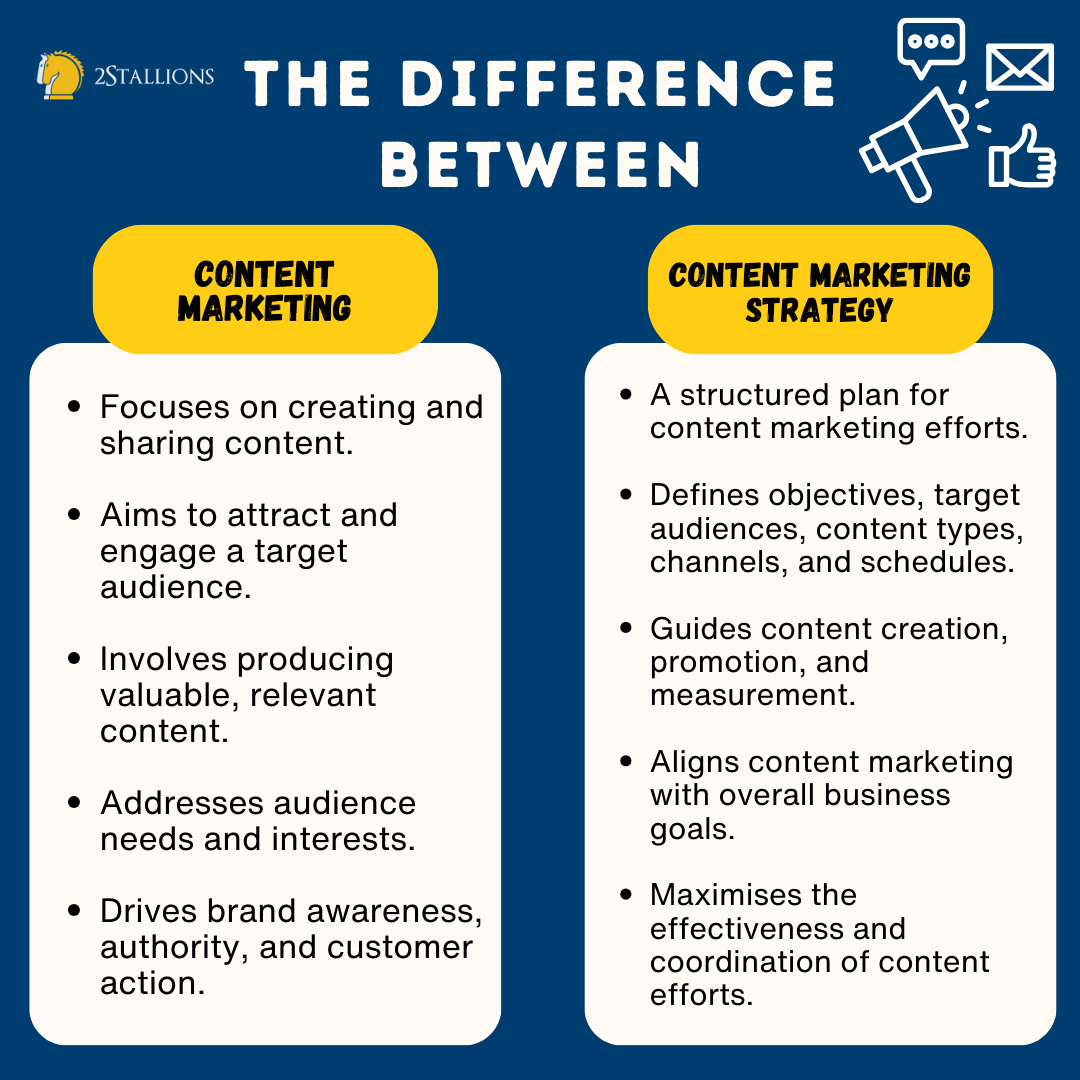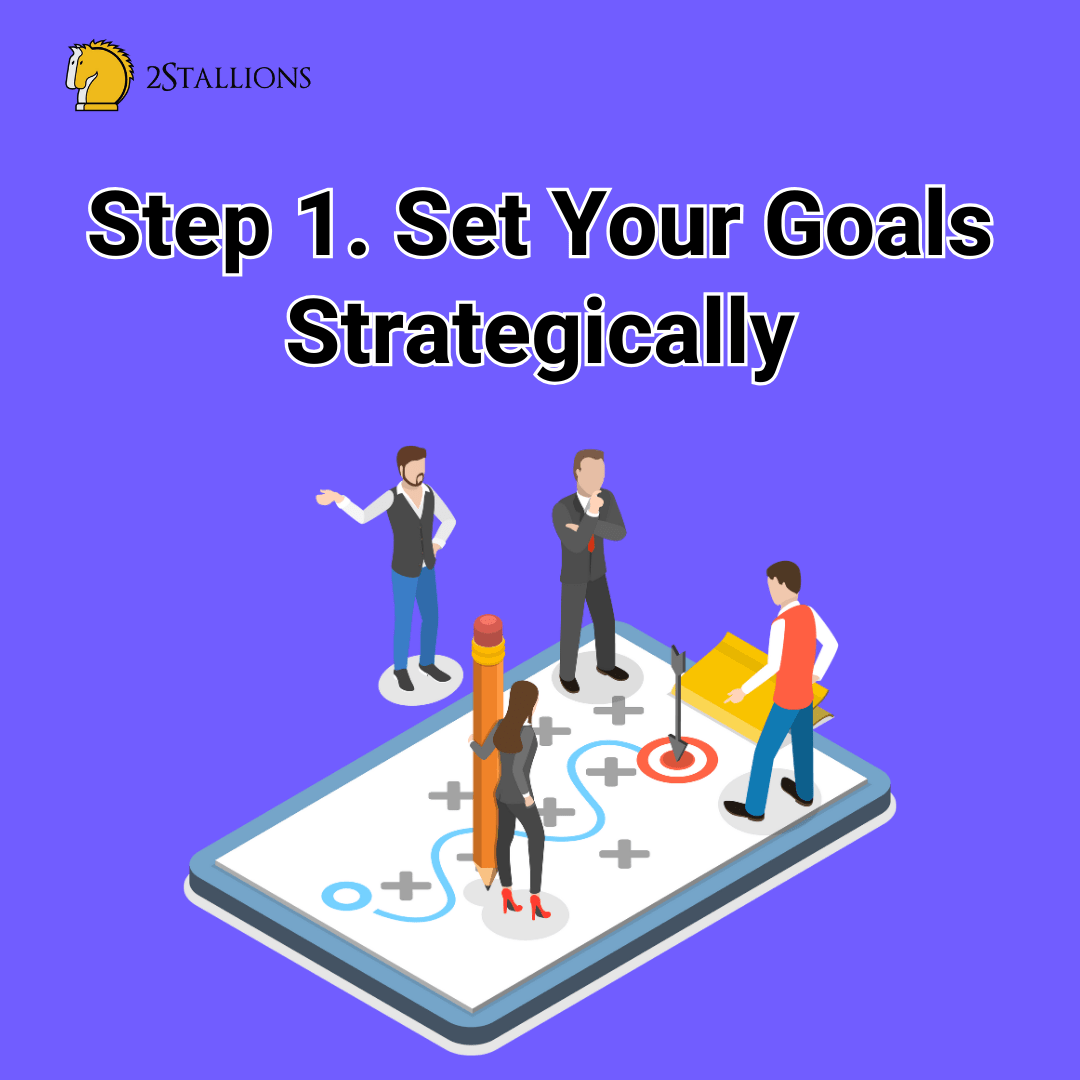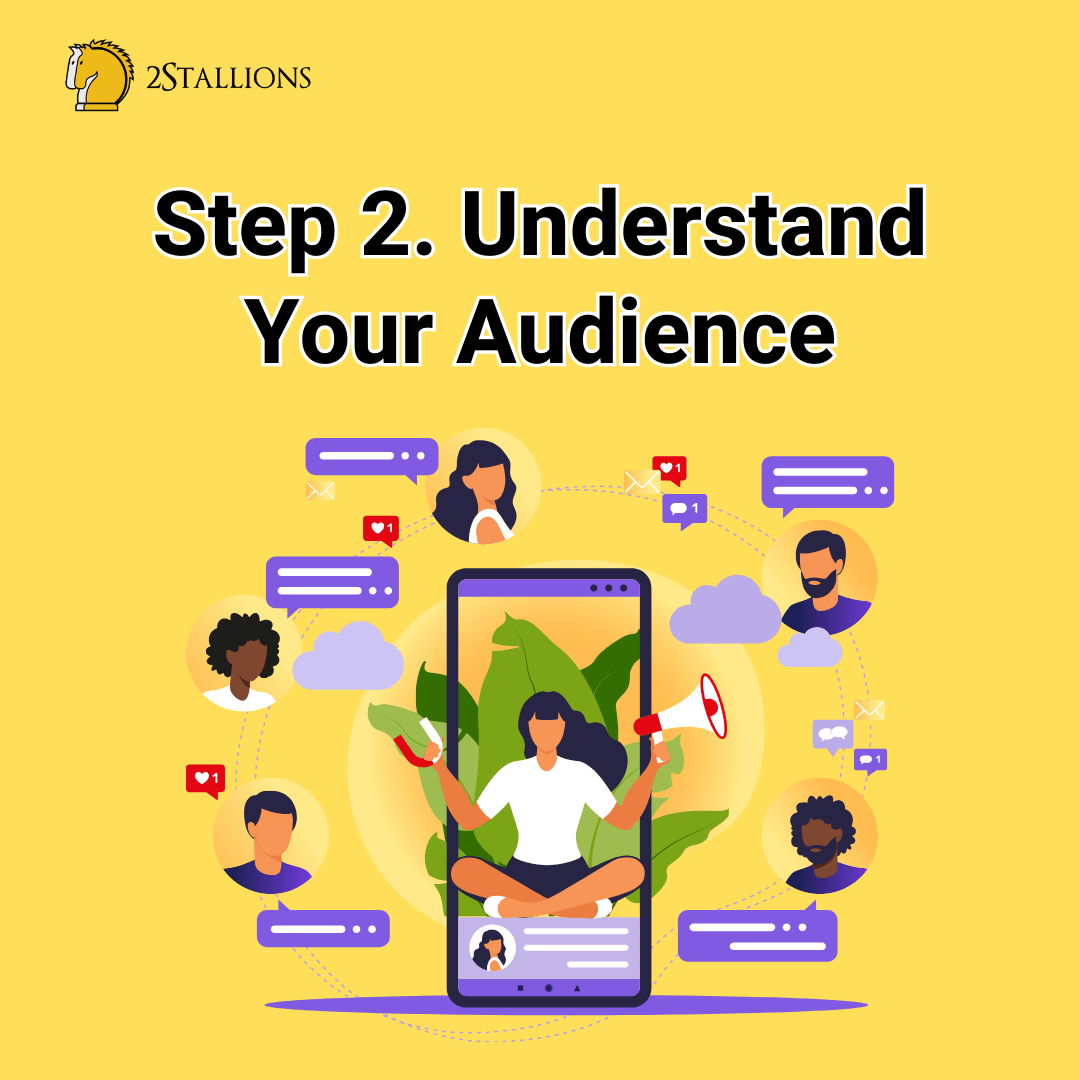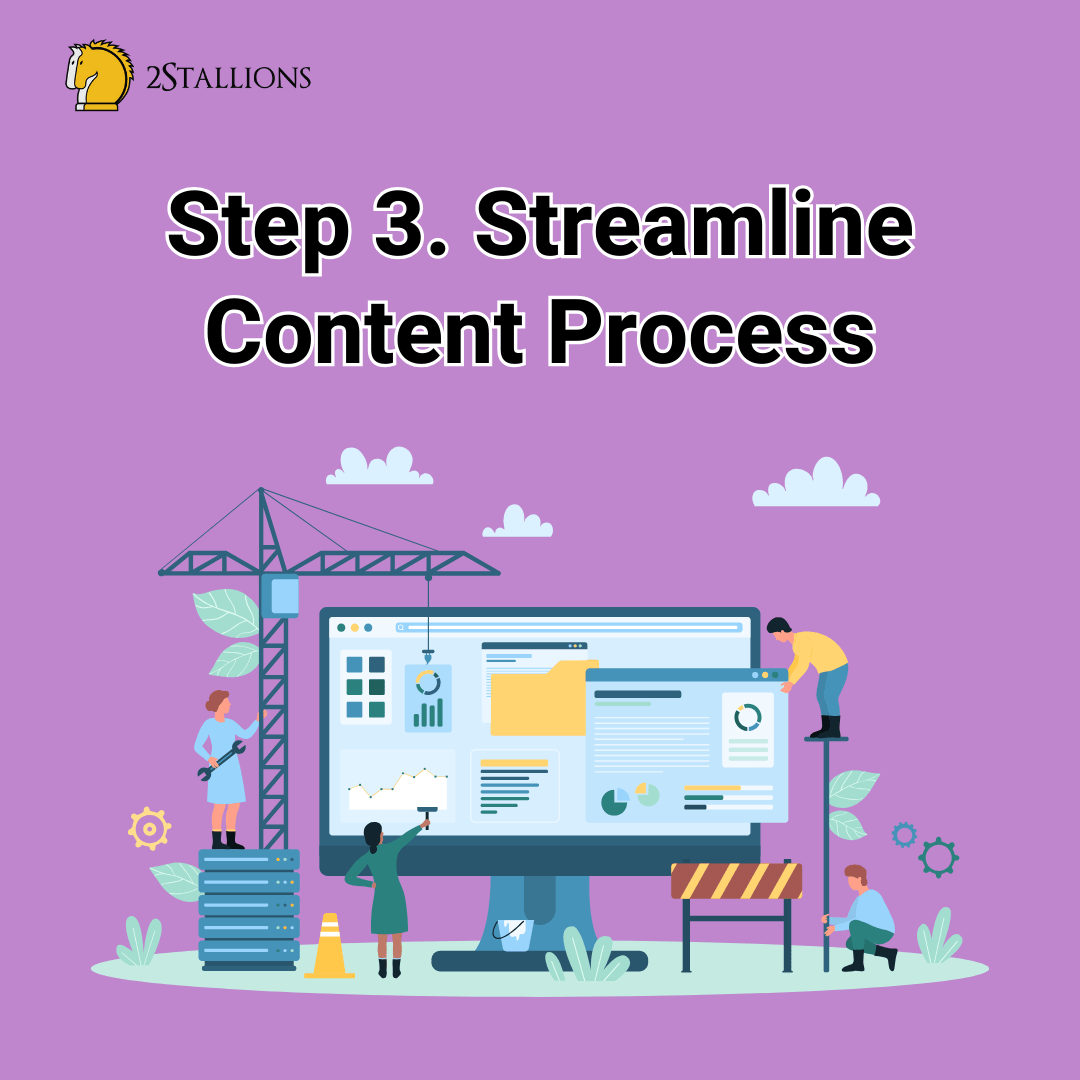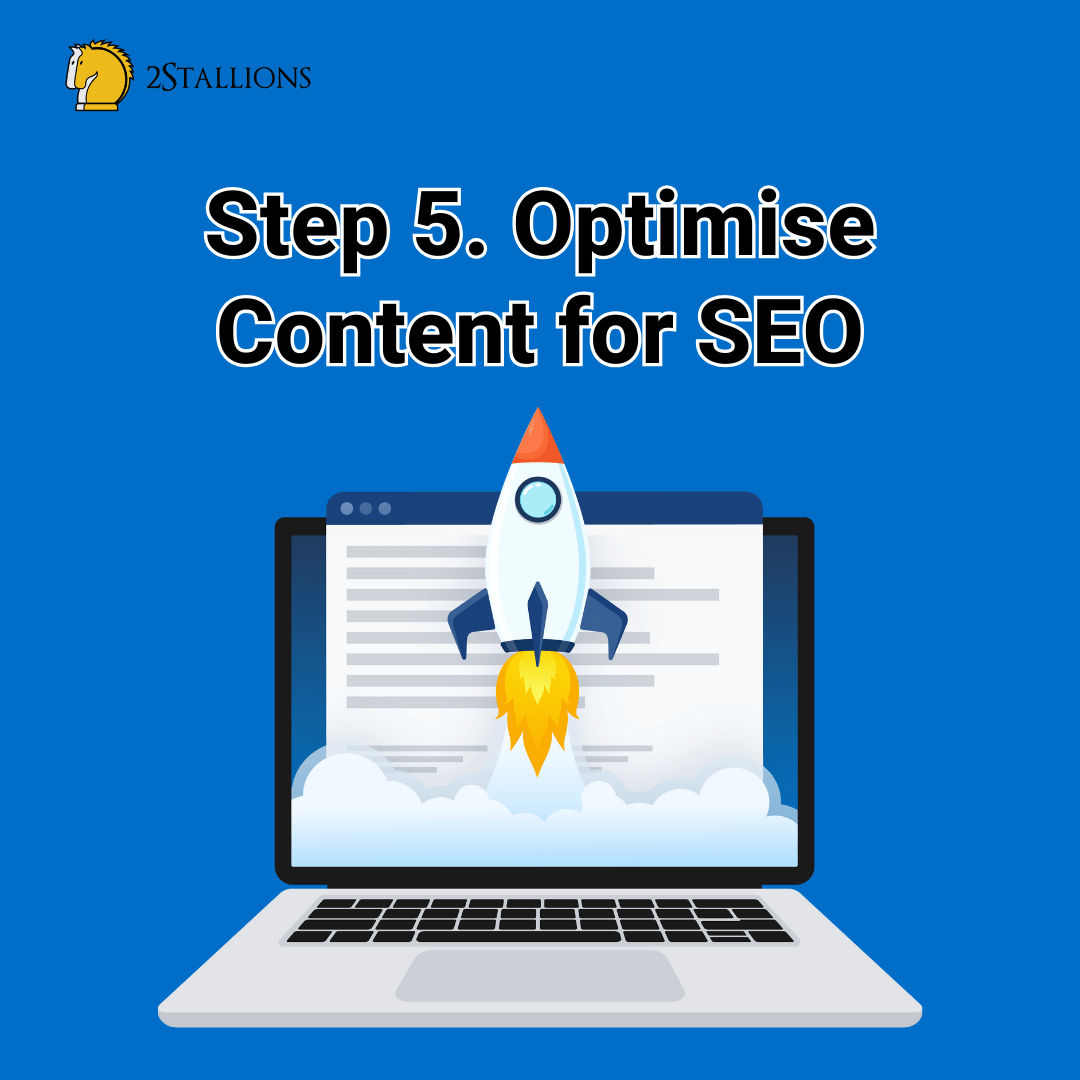SHARE

A well-crafted content marketing strategy is indispensable for businesses aiming to distinguish themselves in a competitive online environment. A successful content marketing strategy involves creating valuable content and ensuring it reaches the right audience. Suppose you’re wondering how to develop an effective content distribution strategy while adhering to your content management strategy. In that case, you’re in the right place. In digital marketing, “content marketing” and “content strategy” are often used interchangeably. Still, they represent two distinct approaches with unique purposes and methods. To truly excel in the world of online content, it’s crucial to understand the fundamental differences between these two concepts.
[thrive_leads id=’8342′]
The Difference Between Content Marketing And Having A Content Marketing Strategy
Content Marketing
Content marketing creates and shares valuable, relevant, and consistent content to attract and engage a target audience. This content can take various forms, including blog posts, videos, infographics, podcasts, and more. Content marketing primarily focuses on creating and distributing content to build brand awareness, establish authority, nurture leads, and drive profitable customer action. Content marketing often involves producing content that addresses the needs and interests of a specific audience, aiming to provide them with helpful information and solutions.
Content Marketing Strategy
A content marketing strategy is a comprehensive and structured plan that outlines how content marketing efforts will be executed to achieve specific business objectives. This involves defining objectives, target audiences, content types, distribution channels, posting schedules, and key performance indicators (KPIs). A content marketing strategy provides a roadmap for creating and managing content that aligns with the company’s overall marketing and business objectives. It includes content creation, promotion, and measurement, ensuring that content efforts are coordinated, consistent, and goal-oriented.
Content marketing is the broader practice of creating and distributing content. In contrast, a content marketing strategy is the strategic framework that guides these efforts, helping organisations achieve their marketing and business goals more effectively. A well-defined content marketing strategy is essential for maximising the impact and ROI of content marketing initiatives. If you’re unsure of how you can start your content marketing strategy, you’re in the right place. This guide will walk you through five simple steps to help you develop a content marketing strategy to drive results and grow your business.
As a trusted content marketing agency, 2Stallions develops compelling content strategies that boost your brand’s online presence. Schedule a free consulation with us now.
5 Essential Steps to Help You Develop an Effective Content Marketing Strategy:
Step 1. Set Your Goals Strategically
Step 2. Understand Your Audience
Step 3. Streamline Content Process
Step 4. Distribute Content Effectively
Step 5. Optimise Content for SEO
Step 1. Set Your Goals Strategically
Before diving into the intricacies of content marketing, it is essential to have a robust content management strategy in place. This strategy is the backbone of your content marketing efforts, ensuring that your content aligns with your business goals.
Define Your Objectives:
To start crafting your content marketing strategy, it’s important to establish clear objectives. Ask yourself what you aim to achieve with your content marketing efforts. Are you looking to increase brand awareness, generate leads, drive sales, or position your brand as an industry leader? Knowing your goals will guide your entire strategy.
Audience Segmentation:
Understand your target audience. Who are they? What are their pain points, interests, and behaviours? Create buyer personas to cater to different segments effectively.
Keyword Research:
Identify keywords that resonate with your target audience and are relevant to your industry. Utilise tools like Google Keyword Planner to find high-traffic, low-competition keywords.
Content Types:
Determine the types of content that will best resonate with your audience. This could include blog posts, videos, infographics, webinars, or various formats.
Content Distribution Channels:
Decide where and how you will distribute your content. Popular channels include your website, social media, email marketing, and third-party platforms.
Content Calendar:
Create a calendar to plan your content production and distribution over time. This ensures a consistent flow of valuable content.
Performance Metrics:
Establish key performance indicators (KPIs) to measure the success of your content marketing strategy. Common KPIs include website traffic, lead generation, conversion rates, and social engagement.
Budget and Resources:
Determine the funding and resources needed for your content marketing efforts. This may include content creation, advertising spending, and team members.
Content Guidelines:
Develop content guidelines and style preferences to ensure consistency and maintain your brand’s voice and tone.
Content Promotion:
Strategise how you will promote your content. Will you use paid advertising, influencer partnerships, or organic reach through SEO?
Step 2. Understand Your Audience
Your audience is at the heart of your content marketing strategy. To resonate with them, you need to know who they are, what they need, and how your content can address their concerns.
Conduct Comprehensive Audience Research:
Begin by gathering data on your target demographic. Understand their demographics, interests, pain points, and online behaviour. Tools like Google Analytics and social media insights can provide invaluable information.
Create Audience Personas:
Develop detailed audience personas that represent your ideal customers. This step humanises your audience, making tailoring content to their preferences easier.
Analyse Existing Data:
Review past content performance. Identify which pieces resonated most with your audience. This analysis will offer insights into the type of content your audience prefers.
Conduct Surveys and Feedback:
Engage with your audience directly through surveys or feedback forms. This approach allows you to gather specific information about their preferences and needs.
Monitor Competitors:
Keep an eye on your competitors. What are they doing that resonates with a similar audience? This can provide valuable insights into the content your audience finds appealing. By diligently following these steps, you can develop a profound understanding of your audience, which is fundamental to crafting an effective content management strategy. Tailoring your content to their preferences and needs will significantly enhance the impact of your content marketing endeavours.
Step 3. Streamline Content Process
First and foremost, it is essential to recognise that an effective content marketing strategy hinges on an efficient content management strategy. To ensure that your content marketing efforts yield optimal results, you must streamline how you create, curate, and organise content. A well-defined content management strategy will enable your team to work seamlessly and ensure consistency in content production.
Define Your Content Goals and Objectives:
Establish precise, measurable goals for your content marketing efforts. These goals should align with your overall marketing objectives and target audience. By defining these goals, you’ll have a roadmap for your content strategy.
Assign Roles and Responsibilities:
It’s crucial to designate specific roles and responsibilities within your team. Whether content creation, editing, or distribution, everyone should know their tasks and be accountable for their contributions.
Implement Efficient Collaboration Tools:
Utilise tools and software that enable remote collaboration and streamline communication among your team members. This will ensure everyone is on the same page and can work together seamlessly.
Content Reuse and Repurposing:
Make sure to use your valuable content wisely. Identify opportunities to repurpose existing content into different formats (e.g., blog posts into infographics, videos, or social media updates). This approach maximises your content’s reach and longevity.
As you streamline your content process, remember your audience’s needs and preferences. An effective content management strategy ensures efficiency and delivers content that resonates with your target audience. Integrating these steps into your content marketing strategy checklist will create a streamlined and efficient content process that lays a solid foundation for your content marketing efforts.
Step 4. Distribute Content Effectively
Once you’ve created high-quality content, your next task is to ensure it reaches the right people at the right time. Effective content distribution is the key to maximising the impact of your efforts.
Understand Your Audience:
Before distributing content effectively, you must know your audience inside and out. Develop detailed buyer personas and tailor your distribution strategy to address their preferences, pain points, and interests.
Choose the Right Channels:
Not all content distribution channels are created equal. Depending on your target audience and goals, your content may perform better on specific platforms such as social media, email marketing, content syndication, or even influencer partnerships. Analyse your options and focus your efforts on the most relevant ones.
Content Format Optimisation:
Different content formats resonate with diverse audiences. For example, some prefer video content, while others prefer written articles or infographics. Ensure your content is optimised for the preferred format of your target audience.
Content Scheduling:
Timing is everything in content distribution. Create a content calendar considering the best times to reach your audience on various platforms. Consistency in posting and sharing is key to maintaining engagement.
Leverage SEO and Paid Promotion:
Use Search Engine Optimisation (SEO) best practices to increase your content’s visibility. Additionally, consider paid promotion options such as social media advertising or pay-per-click (PPC) campaigns to boost your content’s reach. Remember, content distribution aims to get your content in front of as many eyes as possible and in front of the right eyes. Relevance and engagement should consistently serve as your guiding principles. Monitoring and analysing the performance of your distributed content is equally important. Regularly track key metrics and adjust your strategy to ensure continuous improvement.
Step 5. Optimise Content for SEO
A content Management Strategy, how you develop an effective Content Distribution Strategy and a Content Marketing Strategy Checklist are all fundamental building blocks for a comprehensive content marketing strategy. However, to ensure your content stands out in the ever-expanding digital landscape, it’s imperative to optimise it for search engines or, in other words, for SEO.
Keyword Research and Integration:
Your content strategy should begin with thorough keyword research. Identify relevant keywords and phrases that align with your target audience’s search intent. These keywords, including “content management strategy,” “how do you develop an effective content distribution strategy,” and “content marketing strategy checklist,” should be strategically integrated into your content, ensuring natural and seamless incorporation.
High-Quality Content Creation:
Valuable, informative, and engaging content is the backbone of a successful content marketing strategy. Your content should address your audience’s needs and interests and be well-structured, error-free, and unique. Google rewards high-quality content with higher search engine rankings.
On-Page SEO Optimisation:
Optimise on-page elements to make your content more search-engine friendly. This involves using relevant title tags, meta descriptions, and header tags. Additionally, ensure your content is well-structured with proper formatting and internal links.
Mobile-Friendly Design:
With the increasing use of mobile devices, Google prioritises mobile-friendly websites in its rankings. Ensure your content is easily accessible and looks great on all screen sizes. Google’s mobile-first indexing places importance on mobile compatibility.
Backlink Building:
Acquiring high-quality backlinks from reputable sources can significantly boost your content’s SEO. Backlinks act as endorsements of your content’s authority, signalling to search engines that your content is valuable and trustworthy.
The Takeaway
It will require some time before your content marketing strategy produces noticeable results… Nonetheless, you should still make your content marketing strategy the heart of your marketing initiatives. It’s crucial for building your brand identity and earning the trust of your target audience. Whether you’re new to building a content marketing strategy or you’ve been using the same approach for a while, it’s important to constantly revise your plan to ensure it stays up-to-date, innovative, and engaging for your customers.
Use this five-step guide to develop a strategic approach to drive online visibility and growth for your business.
Elevate Your Digital Approach with 2Stallions: Your Route to Content Excellence! Discover top-tier content marketing solutions to elevate your brand’s visibility through our unmatched services. Step into a world of limitless possibilities – contact us and embark on this transformative journey with us today!
Originally published: 30 June 2020
Updated: 25 October 2023
Frequently Asked Questions about Content Marketing Strategy
What Steps Would You Take To Develop A Content Marketing Strategy?
Developing a content marketing strategy involves several key steps.
1. First, you should define your goals and target audience.
2. Research to understand your audience’s needs and preferences.
3. Create a content plan that outlines the type of content you’ll produce, such as blog posts, videos, or infographics. Establish a content calendar to ensure a consistent posting schedule. Promote your content through various channels, including social media and email marketing.
4. Finally, regularly analyse and measure the performance of your content to make necessary adjustments and improvements.
What Are The 5 C's Of Content Marketing?
The 5 C’s of content marketing are:
Content: Create valuable, relevant, and high-quality content.
Context: Ensure your content is tailored to your target audience and their needs.
Channels: Distribute your content through appropriate channels, such as social media, email, and your website.
Consistency: Maintain a regular posting schedule to keep your audience engaged.
Community: Engage with your audience and build a community around your content to foster loyalty and brand advocacy.
What Are The 5 Key Marketing Strategies?
The five key marketing strategies are:
Content Marketing: Creating and sharing valuable content to attract and engage a target audience.
Social Media Marketing: Using social platforms to connect with customers, build brand awareness, and drive traffic.
Email Marketing: Sending targeted emails to nurture leads and maintain customer relationships.
Search Engine Optimisation (SEO): Optimising your website to rank higher in search engine results and increase organic traffic.
Paid Advertising: Using paid campaigns on platforms like Google Ads or social media to reach a wider audience.
How Do You Create A Content Strategy Step By Step?
To create a content strategy, follow these steps:
Step 1: Set clear objectives and define your target audience.
Step 2: Research to understand audience needs and preferences.
Step 3: Develop a content plan, including content types and topics.
Step 4: Create a content calendar with a posting schedule.
Step 5: Assign responsibilities and allocate resources.
Step 6: Produce, publish, and promote content.
Step 7: Measure and analyse content performance using key metrics.
Step 8: Adjust your strategy based on data and feedback.
What Is An Effective Content Marketing Strategy?
An effective content marketing strategy aligns with your business goals, resonates with your target audience, and consistently delivers valuable content. It involves understanding your audience’s pain points and interests, tailoring your content to address those needs, and using various channels to reach and engage your audience.
Key performance indicators such as website traffic, lead generation, conversion rates, and audience engagement measure effectiveness. Regularly analysing these metrics and adapting your strategy is essential for long-term success in content marketing.


